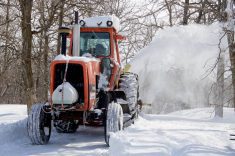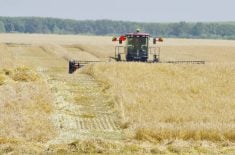Overview
Harvest progress sits at 15 per cent completed across the province, well behind the 5-year average of 51 per cent completed by this time. The effect of delayed seeding, high humidity and frequent rains have had an impact delaying harvest. Ideal harvesting conditions allowed for significant progress this past week.
Crop condition looks good to very good in most parts of the province, while the bulk of the crops have been desiccated.
Read Also

New ranking elevates Assiniboine College to national research elite
Brandon’s Assiniboine College is 47th in a national ranking measuring research dollars and output at publicly funded institutions in Canada.
Spring wheat harvest is expected to become widespread later this week as crops dry down and weather forecasts remain warm and sunny.
Lodged crops due to recent isolated heavy rain and wind events in some regions have disrupted smooth harvest operations in peas and some cereals.
A limited start to soil testing has begun in fields already harvested.
Cereals
Winter cereal grains
Fall rye harvest nearing completion. Reported yields are between 45 to 110 bu/acre, averaging between 75 to 90 bu/acre. Straw volumes are high and swathing is common.
Higher levels of ergot have been reported in fall rye.
Many farmers have commented that they are intending to seed more fall rye this autumn if conditions remain favourable, especially on ground that had been summerfallowed due to excessive moisture.
Winter wheat is also nearing completion, yield reports are between 30 to 80 bu/acre, averaging in the 60 to 70 bu/acre range.
Winter wheat grain samples from the Eastern region are running into higher levels of fusarium.
Spring cereal grains
Spring wheat harvest is on-going in all regions. Good harvesting weather has aided producers.
The spring wheat crop is rated mostly good to excellent.
Pre-harvest dessicant applications are wrapping up on wheat. Crop maturity is less uniform in some
locations due to delayed seeding/emergence, or weeds above the crop canopy.
Harvest has progressed in the past week with 31 per cent harvested to date. Yield averages are reported between 60 to 70 bu/acre across the province.
Early harvest indications in the Eastern and Central regions are showing CWRS wheat protein ranging
between 12.5 to 14.8 per cent, with good test weight between 61 to 66 lbs/bushel.
Spring wheat is showing moderately higher FDK (fusarium damaged kernels) than recent years due to
wetter conditions, but low DON levels, and nearly all grading No 1 CWRS.
Barley harvest has begun with average yields of 65 -90 bu/ac. Some Barley being delivered to grain buyers has been tough (>13.5 per cent seed moisture) however.
Oat harvest has begun. Reported yields are between 100-180 bu/ac with the average in the 140 bu/ac
range. Good test weights are being reported. Some green stem issues have delayed harvest in the Central region.
Corn
Corn development has reached R5 (Dent) stage in the most advanced fields with later planted fields slightly behind.
Oilseeds
Canola
Canola harvest has begun across Manitoba, some desiccation is on-going on later planted fields. Swathing is common on uneven fields. Late seeded fields are still in the pod-fill stage.
Average canola yields are at 45 to 55 bu/acre.
Canola harvest will continue this week given favourable weather.
Insect pressure remains low in most canola, except in the Interlake and Swan Valley, where lygus bug
populations have exceeded economic thresholds and require spraying. Late-season adult flea beetles are increasing in number and are being monitored.
Flax & sunflowers
Flax is rapidly turning colour with the combination of heat and moisture. The crop has been turning fast, preharvest applications are beginning or will start soon depending on the field.
Sunflowers are in the R7 stage, back of heads turning pale yellow to R8 stage, back of heads fully yellow but bracts remain green.
Pulses
Soybeans have reached the late R6 to R7stages, and are benefitting from abundant August rainfall. White mould has been reported in dense-canopy soybean crops, but is not a yield concern due to late infection.
Soybean fields are rapidly turning colour on the earlier varieties, and remain quite green on the longer- season varieties.
Grasshoppers are finding their way back into green soybeans after nearby cereal crops are cut in the Dauphin area. Aphid populations are rising in soybeans in the Portage la Prairie area, while other areas are seeing less insect pressure as crops mature.
Field pea harvest is on-going in all regions to varying degrees – harvest is most advanced in the Northwest region, at 99 per cent complete. Reported yields are 50 to 60 bu/acre on lighter land, while better land is seeing yields between 70 to 80 bu/acre.
Dry beans harvest has started on early pinto fields with kidney and cranberry harvesting expected to begin later this week. No yield estimates at this point.
Special crops
Harvest of direct-delivery fresh potatoes had a limited start this week, growers are reporting average yields.
Potato yields were somewhat less than expected due to early season excess moisture stress, but quality
appears good with no late blight development.
Hemp crops are advancing to maturity, yields will see a boost from abundant August rainfall in most growing areas.
Forages & livestock
Forages
Cattle producers are still putting up feed, and yield remain above average.
Barley silage is ongoing, and recent rains have helped pastures sustain growth, and growers are satisfied there will be sufficient grazing forage late into the season in the Southwest region.
Meadow accessibility is still limited low-lying areas near Lakes Manitoba and Winnipeg, but where haying has been done, yields are as much as three times higher than in 2021.
Hay volumes have been good, but quality remains the challenge. Producers, particularly cattle producers trying to put up dry hay, are often frustrated by rain, humidity and damp swaths.
Alfalfa is in the critical fall harvest period, and cannot be cut until after a killing frost without increased risk of winterkill.
Livestock
Pasture growth has slowed in most areas, as expected for late summer, and cattle feed supplies are adequate. Overgrazed pastures in the Northwest region have little to no regrowth.
Dugouts and sloughs are at 65 to 70 per cent capacity in the Southwest region, while creek flows have slowed.
Dugouts remain nearly full in the Interlake and Eastern regions.
Livestock water supplies remain sufficient.
Regional comments
Southwest
Weather conditions were good for harvest with many producers harvesting over the past few days. Hot and dry conditions allowing crops to mature. Late seeded crops are catching up as well. Some longer season crops like soybean, corn and sunflower are showing up the signs of moisture stress. A few areas have high grasshopper pressure.
Northwest
High temperatures and warm, drying winds helped harvest progress nicely across the region. Some precipitation mid-week with the Rorketon weather station receiving the most at 15.5 mm. For the most part, there was very little pause in harvest progress. Harvest is most advance in the Roblin and Swan Valley areas as these areas were first seeded. The warm temperatures and winds have allowed a few late nights of harvest.
Central
Many producers started in earnest in cereal crops this week, spring wheat yields in the Red River Valley are running between 60 to 90 bu/acre, with many fields averaging above 70 bpa. Wheat harvest is about 45% complete in the region. A few canola fields are in swath, while many are ripening and drying down ahead of direct harvest. The earliest (desiccated) fields have been harvested. Southern parts of the region are a little more advanced in harvest progress further north, where it has been wetter and remained greener later into the season. Potato harvest is underway.
Eastern
For the first time in a long time, a week with no rain!! Weather was mixed clouds to sunny most of the week with mostly above normal to normal temps favourable for harvesting. Field, hayland and pasture access continued to improve. Grain farmers moved into harvesting mode now. Expect much more general harvesting and haying activity to continue to build through this week across the region. Concerns about plant diseases and insects are mostly at an end. Some agronomists still watching for late season flea beetles in canola which was an issue last year, however no spraying for them has occurred. Sunflowers showing some head rot in spots but overall still look healthy and existing hot/dry weather will help preserve them until end of season
Interlake
Canola swathing and desiccation continues. Very limited canola harvesting has taken place (1 per cent harvested) with early yield reports of 45 bu/ac. Spring wheat harvest estimated to be 10 per cent complete with yields ranging from 50-80 bu/ac (70 bu/ac average). Producers are reporting tough grain and straw as the crop has not yet dried down fully, leading to short harvesting days and portions of fields being left to dry down further. Some fields have significant drowned out areas due to earlier excessive rains, so this will decrease average yields. This will become more apparent as harvest progresses.















